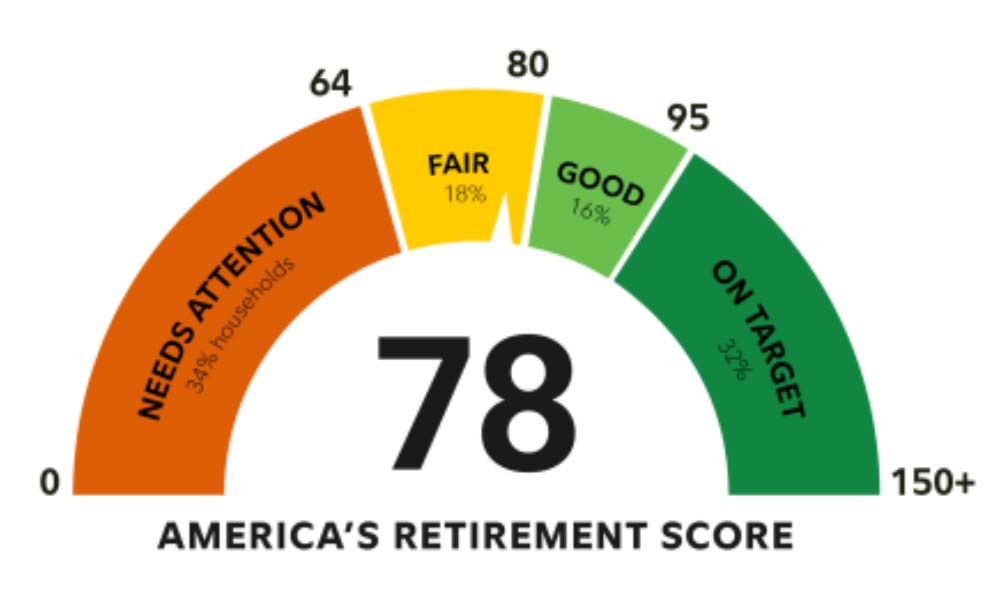 Contact
About Us
Articles
Home
Contact
About Us
Articles
Home

Although you may be setting money aside for the future, will you really be ready for retirement when the time comes?
Unfortunately, the financial planning landscape is loaded with myths and misconceptions about how to best go about planning for retirement. So, chances are that you may not necessarily be on the right path to the future financial security that you’ve been dreaming about.
While there is no such thing as a one-size-fits-all method for retirement income planning, though, there are some essential components that must be addressed in most everyone’s plan in order to achieve success.
With that in mind, it is critical that you understand whether or not you’re truly on the right path to financial security in retirement or if there are still some gaps you need to fill in, as well as some misconceptions to overcome.
Retirement represents the ultimate financial goal for millions of people across the country – and around the world! One of the biggest reasons is that almost everyone relishes the idea of not having to set an alarm clock and spend 40 (or more) hours every week in “work mode.”
The way you spend your time in retirement can differ from everybody else, though. For instance, some people look forward to embarking on new adventures traveling the globe, while others simply want to relax on the beach or play golf.
In any case, however, it is mandatory to have incoming cash flow that is enough to cover your “essentials” like housing, health care and food and ideally to have some left over for non-essentials, too, such as entertainment, dining out and having fun.
While saving and investing are certainly primary components of getting you where you want to go financially in the future, it is really just one rung of the overall retirement preparedness ladder.
How close are you to hitting the mark on your future financial security?
Unfortunately, if you’re like many other Americans, you may actually be losing traction. But the sooner you know where you stand, the more quickly you can put a plan in place to get back – and stay – on track going forward.
So, how do you know where you “score” when it comes to retirement preparedness?
The findings from a recent survey could help.
Each year, Fidelity conducts a study on America’s preparedness level for retirement – and the information that was determined from its 2022 survey was a bit alarming. After reviewing extensive data collected from more than 3,500 participants, the investment firm found that less than 50% of working American households are likely to be able to cover at least their essential expenses in retirement.
Of the remaining survey participants, 18% fell into the “fair” category, and 34% of the households were in the “red zone” – which represents an increase of roughly 6% since the Fidelity 2020 survey was conducted.
What exactly do these percentages represent?
They primarily have to do with whether or not the participants were on target to generate the amount of income that Fidelity estimates they will need for covering their expenses in retirement.
Given the extreme volatility of the stock market, along with changing interest rates, the results that were presented in this particular survey place U.S. households into four primary categories on the retirement preparedness “spectrum,” based on their ability to cover estimated expenses in a down market.
| Needs Attention | Fair | Good | On Target |
|---|---|---|---|
| Needs AttentionSignificant adjustments to retirement lifestyle are likely. | FairModest adjustments to retirement lifestyle are likely. | GoodAble to cover at least the essential expenses in retirement (like housing and food), but not discretionary expenses uch a travel, entertainment, fun, etc. | On TargetAble to cover more than 95% of total estimated expenses, which includes both essential and non-essential costs. |
| Needs Attention34% of U.S. households are in the "red zone," which is up from 28% in 2020. | Fair18% of U.S. households are in the yellow zone, which is flat compared to the 2020 data that was collected by Fidelity. | Good16% of U.S. households are in the green zone, which is down from 17% in the 2020 survey. | On Target32% of U.S. households are in the dark green zone, which is down from 37% in 2020. |
As a whole, America rates in the “fair” category for retirement readiness, which is down somewhat from the results of Fidelity’s 2020 retirement preparedness survey. In addition to the market-related impact, one of the biggest reasons behind this decline over the past few years includes the effects of the COVID-19 pandemic and the corresponding changes in many Americans’ income and savings ability.

Given the more than 50% of the Fidelity survey participants who were deemed not to be on target for meeting their retirement expenses, taking action sooner rather than later is critical. Otherwise, changes to one’s future lifestyle will be necessary in order to stay afloat financially.

The falling retirement preparedness scores in the United States have also sparked more doubt in terms of how confident investors are about retiring – and these scores may be a big motivating factor for only one in three Americans feeling “very confident” about their ability to have enough money to live comfortably in the future.
The 2022 Retirement Confidence Survey conducted by the Employee Benefits Research Institute (EBRI) found that just under three-quarters of American workers (or roughly 73%) feel confident in their ability to have enough money to live comfortably throughout their retirement time frame.
Further, more than 35% of workers are either “not too confident” or “not at all confident” that they will have enough money to cover their medical expenses in retirement – which can comprise a significant percentage of overall income.
There are several key contributors that have impacted this low confidence level in retirement readiness, including:
For instance, individuals or couples who have money invested in an employer-sponsored defined contribution plan, such as a 401(k) or an individual retirement account (IRA) are twice as likely as those without any of these plans to be at least somewhat confident about their financial security in retirement.
In addition, approximately 56% of current workers state that debt is an issue for them. Roughly 35% of retirees also state the same. Unlike a few decades ago, when many retirees were no longer saddled with mortgage, vehicle and/or credit card obligations, today’s workers and retirees often struggle with these types of debt, even in their golden years. Unfortunately, these and other types of debt have the ability to derail retirement savings and future income generation.
Another factor that has led to reduced retirement readiness, as well as a reduction in confidence about retiring, is a decline in savings. In this case, even though Americans across all generations have more money saved (on average) than they did in 2020, the baby boomer and millennial groups have decreased their savings rates. These savings rates by generation are down by 0.2% and 2.2%, respectively.
Similarly, age-appropriate equity allocations have also declined for many Americans who are working their way toward retirement. Based on the findings of the Fidelity retirement preparedness study, many workers and investors in younger generations do not carry the appropriate number of equities, as it relates to their long-term investment goals.
This means that over time, their investment portfolios may not experience as much growth as they otherwise could, in turn, leading to a lower overall asset value down the road, as well as to a loss of future purchasing power. The end result here is that lower assets in one’s portfolio could reduce the amount of income that is ultimately generated by the portfolio, thus making it more difficult to pay expenses in retirement.
Some investors and financial advisors use an “asset allocation pyramid” to help with determining how and where different types of assets should be used, based on an investor’s time frame until retirement. This pyramid typically shows cash and cash equivalents (i.e., low or no risk) as the “base,” and the most risky assets (but those with the ability to produce high growth) at the top.
You have likely seen commercials on television or online that tout on about “reaching your retirement number” or amassing a significant net worth in order to be “fully” prepared for retirement.
But, while there is some amount of validity to these ads, the truth is that a successful retirement has less to do with having a large pile of assets saved, and much more to do with generating one or more lifetime income streams – streams of income that ideally will last for the remainder of your lifetime, no matter how long that may be.
There are also myths that surround the amount of net income you’ll have available to spend when you retire. For instance, it is possible that you’ve heard some financial professionals state that you will be in a lower income tax bracket when you retire. But that is not necessarily the case.

In fact, depending on how much income you generate from your various sources, you could even pay higher tax rates. And paying higher tax rates can mean having less net spendable income.
This is particularly the case as the U.S. has been languishing in a historically low tax rate environment for the past decade or so, and is anticipated to be exiting it soon. In fact, based on the past 110 years, some economists believe that income tax rates could increase significantly in the near future.
Many people are not aware that in the past, the top federal income tax rate has been as high as 94% – and it has been at 70% or higher in 49 of the past 110 years. So, it is not out of the question that retirees could be hit hard with taxes in the future, allowing for less net spendable income in retirement. With this in mind, having a tax reduction or elimination plan in place in retirement is another crucial factor for ensuring retirement readiness.
Another common misconception that surrounds retirement is that the individual or financial advisory company that helped you accumulate assets is also the ideal choice to see you through your retirement phase of life, too.
However, even if you’ve worked with an experienced financial professional who has helped you with growing and protecting your assets, they might not be the best candidate to take your savings and “convert” them into a reliable, ongoing retirement income that will last for the remainder of your lifetime. In other words, the accumulation of money for retirement can be much different than taking what you have saved and turning it into a reliable income for life.
Preparing for retirement is often compared with climbing up a mountain. In this case, there are various hurdles that you must overcome on your route, along with having the right tools in place to help you reach the summit.
But if that mountain top represents the end of your journey in the working world, it is really only half of the overall battle – because you must also climb back down the mountain and get safely back to the bottom in retirement. And the latter is oftentimes the hardest and most challenging part of the hike.
For this reason, seeking out guidance from a retirement income planning specialist is often recommended for putting a cash flow generation plan in place that can provide you with a financially secure future.
Both workers and retirees alike could find that there are gaps in their retirement plans. Certainly, one of the most common of these is having more expenses than income. But there can be others, too.
For instance, inflation can cause a significant hardship, or gap, in your financial future – and the longer you live, the more troublesome rising prices can be for you. More than eight in 10 of the Fidelity survey participants stated that they were concerned about inflation eating into their finances in retirement.
Keeping up with inflation can require you to put a plan in place that increases the amount of incoming cash flow that you have. This is because while some retirement income generators like Social Security may increase over time, there are others that do not.
It is estimated that an average inflation rate of just 3.2% would require your income to roughly double over a 20-year time period. So, to put this info perspective, if you need $4,000 per month now to meet your current expenses, 20 years from now you would need $8,000 per month just to maintain the same lifestyle.
Without a way to increase your retirement income, though, you could be forced to withdraw more money from your portfolio every year – and this could cause assets to become depleted more quickly. “Drawing down” more money can also intensify portfolio depletion if the stock market incurs a downward cycle. This is because you could have two negative parameters working against you.
Even if you are not prepared or confident about having a financially secure retirement, there are three key preparedness accelerators that you could use that could result in a dramatic improvement to future financial security. These include the following:
Although it may often sound easier said than done, saving as much as possible for retirement is required for moving you toward future financial security. In this case, you should ideally aim to save a minimum of 15% of your pre-tax income every year.
If this just simply is not possible at the present time, though, then you could try to get into the habit of increasing your contribution rate by at least 1% each year until reaching 15%. This is because even slight increases in savings can make a big difference over time. As an example, by just saving an additional $20 per week, you could accumulate an additional $1,000 dollars in one year.
While setting aside money is an essential activity, WHAT you invest those funds in can also make a substantial difference in your overall result. Given that, you must make sure that you have the right mix of assets in your portfolio – including equities, bonds and cash.
The percentages of these assets can change as time goes on and as you inch closer to your intended retirement date. For example, those who have many years before they retire can often take on more risk with their investments – along with the opportunity for more growth. However, the percentage of fixed return assets in your portfolio should typically increase as retirement approaches.
Based on Fidelity’s research, by replacing a portfolio that appears to be either too aggressive or too conservative – based on the appropriate age-related asset allocation – your retirement preparedness score can increase substantially.
In some cases, it may be necessary for you to re-evaluate your overall retirement plan. For instance, if you are able to, waiting a little bit longer to make the leap into retirement could give you more time to build up your savings. Doing so could also raise the amount of retirement income benefits that you get from Social Security.
As an example, for every year that you wait to file for Social Security between your full retirement age (FRA) and age 70, you can obtain an 8% increase in the dollar amount of your monthly benefits.
| Year of birth | Minimum retirement age for full benefits |
|---|---|
| Year of birth1937 or before | Minimum retirement age for full benefits65 |
| Year of birth1938 | Minimum retirement age for full benefits65 + 2 months |
| Year of birth1939 | Minimum retirement age for full benefits65 + 4 months |
| Year of birth1940 | Minimum retirement age for full benefits65 + 6 months |
| Year of birth1941 | Minimum retirement age for full benefits65 + 8 months |
| Year of birth1942 | Minimum retirement age for full benefits65 + 10 months |
| Year of birth1943 to 1954 | Minimum retirement age for full benefits66 |
| Year of birth1955 | Minimum retirement age for full benefits66 + 2 months |
| Year of birth1956 | Minimum retirement age for full benefits66 + 4 months |
| Year of birth1957 | Minimum retirement age for full benefits66 + 6 months |
| Year of birth1958 | Minimum retirement age for full benefits66 + 8 months |
| Year of birth1959 | Minimum retirement age for full benefits66 + 10 months |
| Year of birth1960 or later | Minimum retirement age for full benefits67 |
Therefore, if your full retirement age for Social Security is 66 – and your monthly income at that time would be $2,000 – then waiting an additional four years (until age 70) could increase the amount that you receive each month from $2,000 up to $2,721 – a “raise” of more than 30%!
| Age | Monthly Benefit Amount |
|---|---|
| Age66(full retirement age / FRA | Monthly Benefit Amount$2,000 |
| Age67 | Monthly Benefit Amount$2,160 |
| Age68 | Monthly Benefit Amount$2,332 |
| Age69 | Monthly Benefit Amount$2,519 |
| Age70 | Monthly Benefit Amount$2,721 |
Using all three of the above-referenced strategies together can help you to raise your retirement readiness – in some cases, significantly. In fact, according to Fidelity, if all three of the above actions are applied, America’s total score for retirement preparedness could jump by 30 points. This means that retirees could not only generate enough income to pay their estimated expenses in retirement, but also even more!
But, just as there is no single retirement plan that will work for everybody across the board, different people may have to take differing actions – based in large part on their age / generation, as well as their risk tolerance, and the length of the time period until their intended retirement.
For example, baby boomers – who encompass those who were born in the U.S. between 1946 and 1964 – must be clear on retirement goals. Knowing this, in turn, will dictate the best route to go for getting – and feeling – prepared for retirement. In this case, some of the key questions that boomers can answer to help this along include the following:
The bottom line for baby boomers, then, is to know your plan and to follow it step by step.
Generation X (who are also referred to as Gen X’ers) were born between 1965 and 1980. Many of these individuals are in their prime earning years and could still have a while before their intended retirement date. Those who are in Gen X should therefore continue to increase savings.
Questions to ask yourself if you are a Gen X’er include:
If you are a member of Generation X – and you are age 50 or older – you have some advantages here. For instance, you can add more money into IRAs and employer-sponsored retirement plans, like 401(k)s. So, these extra dollars could help to give you the savings boost that you need as you approach retirement.
| Age | Individual Retirement Accounts (IRAs) | Employer-Sponsored Retirement Plans |
|---|---|---|
| Age9 and under | Individual Retirement Accounts (IRAs)$6,500 | Employer-Sponsored Retirement Plans$22,500 |
| Age50 and over | Individual Retirement Accounts (IRAs)$7,500 | Employer-Sponsored Retirement Plans$30,000 |
Millennials were born between 1981 and 1996. Many in this age group are also starting to plan ahead and save for retirement. If you fall into this generational category, one of the key strategies that you can use is investing appropriately.
Further, those who are millennials typically have time on their side. Therefore, staying invested and making steady contributions into your retirement and other savings plans – even given the current stock market volatility – can help you to grow your retirement savings over time.
Based on Fidelity’s findings, even though millennials experienced the highest increase in income (as compared to other generational groups), they also showed the greatest decline in preparedness for retirement since the previous 2020 survey that was conducted by Fidelity.
Some of the key questions and concepts for millennials to ponder include the following:
Oftentimes, just knowing where you stand today versus where you want to be financially in the future can be a tremendous motivator for getting the right plan in place that can actually help move you toward your short- and long-term goals.
Having a retirement income specialist as your guide on this journey is recommended. That way, you can incorporate all of your goals into one single plan, using the most appropriate tools and strategies for your specific objectives.
If you find that your income will still fall short of your expenses in retirement – and you’ve already increased the amount of money that you’re saving – there are some additional options that could help you to raise your financial readiness in retirement. These may include one or more of the following:
Although it might sound counterintuitive, some people go back to work during retirement. While some may do so for the social interaction it provides, others must take on either part- or full-time employment to help make ends meet.
The internet has made it possible to generate income online, without having to leave your home to make money. If you opt to go this route, though, make sure that the job is legitimate and that it is not just a scam in disguise.
You could also take another close look at expenses and see where you could cut additional costs out. In this case, for instance, you could reduce various services like premium cable television channels and unlimited cell phone services and shop for better insurance rates on your car, home and life.
When doing so, even if you only reduce your monthly outgo by $50 or $100, the savings can really add up, and it could make the difference between a comfortable retirement lifestyle or depleting your savings while they are still needed.
Yet another alternative could be to move in with adult children or other loved ones. While this might not be an enticing option for you, depending on your financial situation, it may be the most viable way for you to stay above water financially in retirement.
In any case, it is absolutely essential to know where you stand right now in terms of your finances and retirement readiness versus where you would ideally like to be. Therefore, working with a retirement income expert can make sense – and it is never “too early” to get started with a plan.
Are you truly prepared for a relaxing and enjoyable retirement? If you’re uncomfortable – or if you just simply aren’t sure of the best avenue for increasing your future financial security – talking over your situation with an Alliance America financial professional can help.
At Alliance America, our primary focus is on making sure that our clients don’t just reach retirement, but that they enjoy this time in their lives without unending worry about their savings or running out of money at a time when they need it the most.
Many of our retirement income strategies make use of assets that our clients already have. In fact, just a simple repositioning of various financial tools often can make a big difference in how your assets work for you.
Alliance America is an insurance and financial services company dedicated to the art of personal financial planning. Our financial professionals can assist you in maximizing your retirement resources and achieving your future goals. We have access to an array of products and services, all focused on helping you enjoy the retirement lifestyle you want and deserve. You can request a no-cost, no-obligation consultation by calling (833) 219-6884 today.


